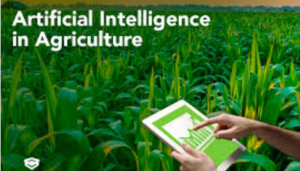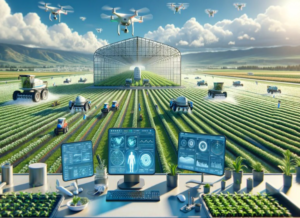Ai in agriculture;

Agriculture is undergoing a technological revolution, with Artificial Intelligence (AI) at the forefront of this transformation. AI is helping farmers increase crop yields, reduce costs, and improve sustainability by enabling smarter, data-driven farming practices. From precision agriculture to predictive analytics and autonomous farming equipment, AI is reshaping the way we grow, manage, and harvest crops. In this blog post, we’ll explore how AI is being used in agriculture, the benefits it brings, and the challenges it faces.
1.Precision Agriculture
Precision agriculture involves using technology to monitor and manage farming practices at a granular level. AI plays a crucial role in this approach by analyzing data from various sources, such as satellite imagery, weather forecasts, soil sensors, and crop health data. By processing this information, AI provides farmers with actionable insights to optimize their farming practices.
For instance, AI-powered systems can analyze soil quality and moisture levels to determine the precise amount of water and nutrients needed for each section of a field. This enables farmers to apply water and fertilizers more efficiently, reducing waste and minimizing environmental impact. Moreover, AI can detect early signs of pest infestations or plant diseases through image recognition, allowing for targeted treatment that prevents crop loss while reducing the use of pesticides.
Precision agriculture not only improves crop yields but also enhances resource efficiency. By using AI to make data-driven decisions, farmers can maximize their output while minimizing input costs and environmental impact.
2. Predictive Analytics for Crop Management
AI’s predictive analytics capabilities are revolutionizing crop management by helping farmers make informed decisions about planting, irrigation, fertilization, and harvesting. By analyzing historical data and real-time information such as weather patterns, soil conditions, and crop health, AI can predict optimal planting times, potential pest outbreaks, and the best times for irrigation and harvest.
For example, AI-powered platforms can use weather forecasting data to predict the likelihood of extreme weather events such as droughts, floods, or frost. Farmers can use this information to take proactive measures, such as adjusting irrigation schedules or deploying protective measures to safeguard crops. Predictive analytics can also forecast crop yields, enabling farmers to plan for market demand and make more informed decisions about pricing and distribution.
These predictive capabilities help farmers mitigate risks, improve crop quality, and ensure a more stable food supply chain. By anticipating challenges and optimizing farming practices, AI reduces uncertainty and enhances the sustainability of agricultural operations.
Also see: Transforming Farming Through AI: AI in Agriculture key points

3. Automated Farming Equipment
Autonomous farming equipment, powered by AI, is transforming the agricultural landscape by automating labor-intensive tasks such as planting, weeding, and harvesting. AI-driven tractors, drones, and robots can operate with precision and efficiency, reducing the need for manual labor and improving overall productivity.
For instance, autonomous tractors equipped with AI and GPS technology can navigate fields with high accuracy, planting seeds at the optimal depth and spacing to maximize yields. AI-powered drones can monitor crop health, apply fertilizers, and even perform targeted pesticide spraying, reducing the use of chemicals and minimizing environmental impact. Harvesting robots equipped with computer vision can identify ripe fruits and vegetables, picking them with the same care and precision as human workers.
Automated farming equipment not only increases efficiency but also addresses labor shortages in the agricultural sector. By using AI to automate repetitive tasks, farmers can focus on higher-level decision-making and farm management, ultimately improving farm profitability.
4.Smart Irrigation Systems
Water scarcity is a critical challenge facing agriculture, making efficient water management essential for sustainable farming. AI is playing a pivotal role in the development of smart irrigation systems that optimize water usage based on real-time data.
AI-powered irrigation systems use data from soil moisture sensors, weather forecasts, and satellite imagery to determine the precise amount of water needed for each section of a field. By applying water only when and where it is needed, these systems minimize water waste and ensure that crops receive adequate hydration for optimal growth.
For example, an AI-driven irrigation system can detect when certain areas of a field are drier than others and adjust irrigation schedules accordingly. This targeted approach not only conserves water but also promotes healthier crops by preventing over- or under-watering.
Smart irrigation systems contribute to sustainable farming practices by reducing water consumption, minimizing runoff, and protecting freshwater resources. As water scarcity becomes an increasingly pressing issue, AI-driven solutions will play a vital role in ensuring the long-term viability of agriculture.
5. Crop Monitoring and Disease Detection
AI is enhancing crop monitoring and disease detection through the use of computer vision, machine learning, and remote sensing technologies. By analyzing high-resolution images from drones, satellites, and ground-based sensors, AI systems can detect early signs of crop stress, pest infestations, and diseases.
For example, AI-powered computer vision algorithms can analyze images of crop fields to identify subtle changes in color, texture, and growth patterns that indicate potential problems. This early detection allows farmers to take corrective actions, such as applying targeted treatments or adjusting irrigation, before the issue spreads and causes significant damage.
Moreover, AI can differentiate between various crop diseases and pests, providing farmers with accurate diagnoses and tailored treatment recommendations. By addressing issues promptly and precisely, AI helps reduce crop losses, improve yields, and minimize the use of chemical inputs.
6. Supply Chain Optimization
AI is not only transforming on-farm activities but also optimizing the agricultural supply chain. From farm to market, AI-powered systems are helping streamline logistics, reduce food waste, and ensure that fresh produce reaches consumers more efficiently.
AI can analyze data on crop yields, market demand, and transportation logistics to optimize the timing and routing of shipments. For instance, AI can predict the best time to harvest and transport crops to ensure they arrive at their destination in peak condition. This reduces spoilage and ensures that consumers receive high-quality produce.
Additionally, AI can help farmers and distributors make informed decisions about pricing and inventory management. By analyzing market trends and consumer preferences, AI can forecast demand and recommend optimal pricing strategies, reducing the risk of surplus or shortages.
also see:The Future of AI in Healthcare: Transforming Diagnostics, Treatment, and Patient Care
7. Climate-Resilient Farming
Climate change poses significant challenges to agriculture, with extreme weather events and shifting climate patterns affecting crop productivity. AI is helping farmers adapt to these challenges by enabling climate-resilient farming practices.
AI can analyze climate data and model the impact of different weather scenarios on crop growth, allowing farmers to develop adaptive strategies. For example, AI can recommend drought-resistant crop varieties, suggest changes in planting schedules, or identify areas suitable for cultivation under changing climate conditions.
By providing farmers with the tools and insights needed to adapt to a changing climate, AI supports the resilience and sustainability of agricultural systems.
8. Challenges and Ethical Considerations
While AI offers numerous benefits for agriculture, it also presents challenges and ethical considerations. One major concern is the digital divide, as small-scale and resource-limited farmers may lack access to the technology and infrastructure needed to implement AI solutions. Ensuring that AI is accessible and affordable for all farmers is essential to prevent widening disparities in agricultural productivity.
Data privacy and security are also important considerations. AI systems rely on vast amounts of data, including farm-level and environmental information. Protecting this data from misuse and ensuring that farmers retain control over their data are critical for building trust and fostering responsible AI adoption.
Additionally, the adoption of AI in agriculture raises questions about the potential displacement of farm labor. While AI-driven automation can alleviate labor shortages and improve efficiency, it may also impact employment opportunities in rural communities. Finding a balance between technological advancement and social equity will be key to ensuring a fair and inclusive transition.
Conclusion
AI is transforming agriculture by enabling precision farming, predictive analytics, automation, and sustainable practices. From optimizing crop yields and reducing resource consumption to enhancing supply chain efficiency and building climate resilience, AI is driving a new era of smart agriculture.
While the potential benefits of AI in agriculture are vast, addressing challenges related to accessibility, data privacy, and social impact is crucial for ensuring that AI adoption is both responsible and equitable. By leveraging AI to create a more efficient, sustainable, and resilient agricultural system, we can meet the growing demand for food while preserving the planet’s resources for future generations.
visit: gamicaltech.com Ai in agriculture Ai in agriculture ai in agriculture ai in agriculture
